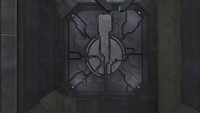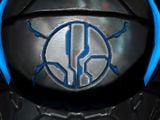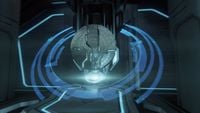Mantle: Difference between revisions
From Halopedia, the Halo wiki
mNo edit summary |
|||
| Line 33: | Line 33: | ||
*''[[Halo: Combat Evolved]]'' {{C|Symbol only}} | *''[[Halo: Combat Evolved]]'' {{C|Symbol only}} | ||
*''[[Halo 2]]'' {{C|Symbol only}} | *''[[Halo 2]]'' {{C|Symbol only}} | ||
*''[[Halo 3]]'' {{ | *''[[Halo 3]]'' {{1st}} | ||
*''[[Halo: Cryptum]]'' | *''[[Halo: Cryptum]]'' | ||
*''[[Halo: Combat Evolved Anniversary]]'' | *''[[Halo: Combat Evolved Anniversary]]'' | ||
Revision as of 21:35, March 26, 2014
The Mantle of Responsibility,[2] commonly referred to as the Mantle, is a belief originating with the Precursors and later associated with the Forerunners. Bridging the social strata between an interstellar Marshall Plan and a religious, but allegedly benevolent stewardship, the Mantle was the Forerunners' entitlement and responsibility for the protection and cultivation of the species and planetary systems within their domain.[3] The Forerunners' culture and their central government was entirely dictated by the Mantle, as were the religious beliefs of individual Forerunners. The Mantle was based around the concept of Living Time; "the joy of life's interaction with the Cosmos". This was also the origin of all of the complex rules involved in the Mantle.[4]
Overview
Forerunner mythology held that the Mantle was passed down to them by an even earlier and more advanced race, the Precursors, who seeded the galaxy with life and were responsible for the creation of many species. The Forerunners believed themselves to be the Precursors' supreme creation; having created the Forerunners, the Precursors had allegedly allowed themselves to peacefully fade away.[5] At the same time, Forerunner beliefs posited that they were only a passing stage in the universe's Living Time, and that superior civilizations would eventually follow them; this belief is also the origin of the name "Forerunner" they chose to call themselves.[6]
The Forerunners' beliefs regarding the Mantle were largely fictitious, manufactured during eons long forgotten to justify their self-appointed position of superiority over other species. In truth, the Precursors had chosen humanity to carry the Mantle.[7] Refusing to accept the Precursors' judgment, the Forerunners rebelled against their creators and drove them to extinction over ten million years before the present.[8] At the final hour of their civilization, however, the Forerunners chose to hand the Mantle down to humans, as the Precursors had always intended. This is the origin of humanity's status as Reclaimers; designated not only as the Forerunners' inheritors, but also destined to assume the Mantle. After the firing of the Halo Array, the small number of surviving Forerunners exiled themselves, believing they should no longer meddle in the affairs of other species.[9] Not all Forerunners agreed with this decision, however. The Ur-Didact defied the Librarian's favoring of humanity and maintained his belief that only the Forerunners were worthy of the Mantle even 100,000 years later.[10]
Some Forerunners doubted the purpose and validity of their version of the Mantle. The Librarian, in particular, had such doubts, and even went so far as to hold it responsible for the downfall of the Forerunners at the hands of the Flood. The then-rampant AI Mendicant Bias believed that the Forerunners used the Mantle to obstruct any change, even that which might eventually be beneficial.[11]
Practices
- "The Mantle. You still hold to that [belief] after all that has happened? After this thing has consumed a million worlds?
Can't you see? Belief in the Mantle sealed our doom! Weakened our [protectorates], bred dependence and sloth. Our [so-called Guardianship] has stripped those we would keep safe of any capacity for self-defense!
Were we such noble [Guardians] when we drew our line and abandoned billions to the parasite?" - — The Librarian[11]
Despite its ultimate ideal to preserve all life, the Forerunners also used the Mantle as a justification for certain questionable practices. As the Forerunners viewed themselves to be above all other species, their Warrior-Servants would not hesitate to wipe out those who stood against them, believing that to defy the Forerunners was to show contempt for the Mantle itself.[12] Their perceived superiority also caused the Forerunners to sequester themselves from other species; allegedly, this was done to protect and preserve all species, including themselves.[13] In addition, the Forerunners considered it heretical for any other species, namely early humanity, to claim to be true inheritors of the Mantle.[14] Rather than allowing every species to rise on their own merits, the Forerunners, following their Mantle, gave them no chance to do so, serving as protectors against any threats that might have forced technological or cultural progression. An unforeseen side-effect was that only the Forerunners were able to hold their own against the Flood, while their charges were unable to defend themselves; the Forerunners had unintentionally left the galaxy vulnerable to Flood infection.[11]
The Rule of the Mantle was the fundamental set of instructions involved with the Mantle and the origin of the Forerunners' most sacred rules regarding life.[15] The Forerunners' scripture surrounding the Mantle was divided into chapters known as Numbers. Notable Forerunners, such as the Didact, would apparently contribute to the Mantle and have their own Numbers which contained short aphorisms or phrases known as Permutations.[16] The Twelve Laws of Making and Moving were a central religious text associated with the Mantle often recited in prayers.[17] A Master of the Mantle was an individual, likely a religious official, whose duties included securing a Forerunner's mental patterns and physical remains into a Durance after an immolation ceremony.[18]
Symbol
The Mantle is represented by a glyph comprising a series of angular, branching lines framed by a circle. This glyph is ubiquitous in Forerunner art, architecture and technology due to the Mantle's wholesome influence on every aspect of Forerunner life. Many Forerunners, mainly Builders, referred to this symbol as the Tree-mark, due to its resemblance to a heavily stylized tree; among Lifeworkers, it was also known as the Eld. While the Forerunners had associated the symbol with the Mantle throughout their history, its origin had been long forgotten. The symbol was also observed among the primitive Forerunner relatives in Path Kethona, who were isolated from the mainline population living in the Milky Way galaxy over ten million years earlier.[19]
An iteration of the ubiquitous Eld symbol found on Installation 05 in Halo 2.
The Mantle glyph seen on top of 343 Guilty Spark in Halo 3.
The Mantle glyph seen on Requiem.
List of appearances
- Halo: Combat Evolved (Symbol only)
- Halo 2 (Symbol only)
- Halo 3 (First appearance)
- Halo: Cryptum
- Halo: Combat Evolved Anniversary
- Halo: Primordium
- Halo 4
- Halo: Silentium
- Halo: Rebirth
Sources
- ^ Halo 4, campaign level Requiem
- ^ Halo 4, campaign level Epilogue
- ^ Halo Encyclopedia, page 164
- ^ Halo: Cryptum, page 267
- ^ Halo: Silentium, page 203
- ^ Halo: Cryptum, page 31
- ^ Halo: Primordium, page 364
- ^ Halo: Silentium, pages 173-175
- ^ Halo: Rebirth
- ^ Halo 4
- ^ a b c Halo 3, Terminals
- ^ Halo: Cryptum, page 50
- ^ Halo: Cryptum, page 113
- ^ Halo: Cryptum, page 112
- ^ Halo: Silentium, pages 31, 312
- ^ Halo: Cryptum, preface ("The peaceful one is at war without and within." —The Mantle, Fifth Permutation of the Didact's Number)
- ^ Halo: Cryptum, page 28
- ^ Halo: Cryptum, page 47-48
- ^ Halo: Silentium, page 142-143





